Exercises (3161)
Shifting exercise: alternating squat and body extension
Power
Individual work
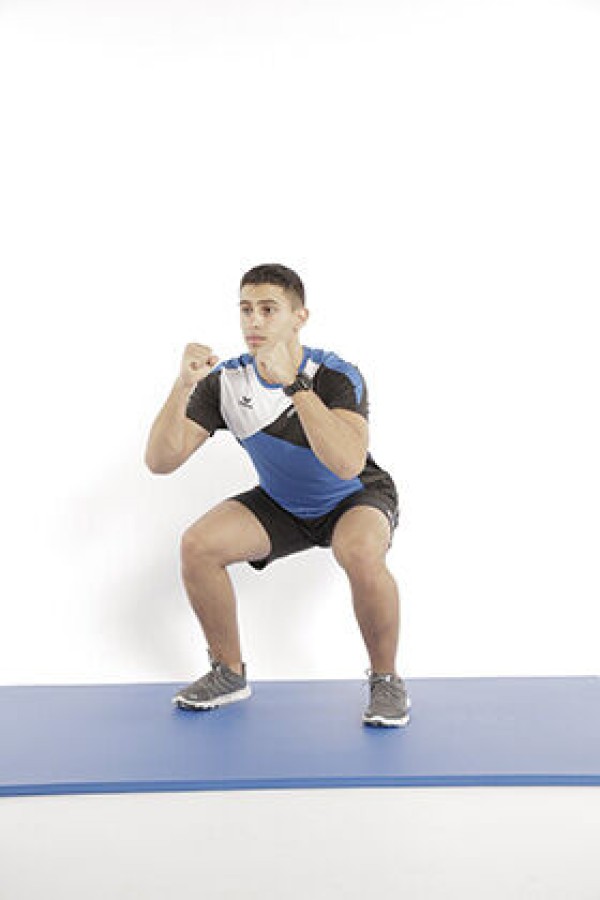
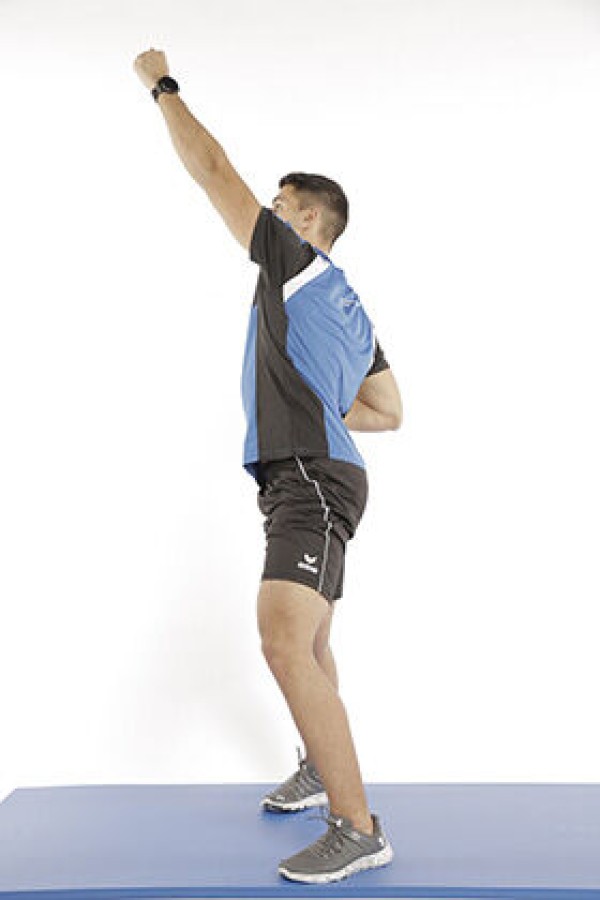
Turned sideways squat with your arms bent in front of your body (hands at chest height). Alternate between stretching one arm overhead (slightly crosswise, upward hook), stretching your legs at the same time and moving them forwards with each stroke/step (bring the back leg forwards) and then returning to the squat position.
Attention:
Bring your buttocks back, not your knees forwards. Keep your knees behind your toes. Keep your back straight at all times.
Lighten:
Do not lower your buttocks too low (larger angle in the knees), reduce the striking movement.
Harden:
Bend your knees more (smaller angle); hold additional weight (on your arms or in your hands).
2 weight cuffs/weight balls/dumbbells/1 weight waistcoat ► Make the exercise more difficult (additional weight)
Displacement exercise: knee lift
Power
Individual work


Stand upright, hip-width apart (starting position, then one leg always moving freely) and alternately raise and lower one knee to navel height in order to move. The arms swing along and support the movement (knee lift). The rhythm/intensity can be varied.
Attention:
Keep your upper body stable/upright, actively support the movement with your arms.
Lighten:
Lift your knees less high; perform more slowly (reduce rhythm/intensity).
Harden:
Lift your knees higher; perform quickly (increase rhythm/intensity); add weight to your legs (hold in your hands).
Variation:
Fold your arms behind your head, move your elbows crosswise towards your raised knee.
2 weight cuffs/weight balls/dumbbells/1 weight waistcoat ► Make the exercise more difficult (additional weight)
Movement exercise: push-up position
Power
Individual work




Shift forwards into a push-up position by moving your arms and legs.
Attention:
Do not arch your back, the upper body and legs should form as straight a line as possible.
Lighten:
Place your knees on the floor and raise your buttocks slightly.
Harden:
Add weight (on the back).
Variant I:
Shift sideways.
Variant II:
Vary the position of the hands/arms (e.g. wide, narrow, together).
1 weight vest/weight disc/sandbag ► Make the exercise more difficult (additional weight)
Shifting exercise: bending one leg sideways in forearm support
Power
Individual work


Shift in forearm support by moving the forearms and legs. When moving the leg forwards, first bend it to the side (knee approximately at hip/belly button height). Try to keep the upper body as low as possible.
Attention:
Do not arch your back, the upper body and legs should form as straight a line as possible.
Lighten:
Place your knees on the floor, stretch your buttocks slightly upwards.
Harden:
Additional weight (on your back).
1 weight vest/weight disc/sandbag ► Make the exercise more difficult (additional weight)
Shifting exercise: bending one leg sideways in a push-up position
Power
Individual work


Push-up position (face down) with the arms slightly offset (place one hand further forwards). Alternately bend one leg and move it to the side of your body (knee to the elbow of the arm further back) in order to shift. Try to keep your upper body as low as possible.
Attention:
Do not sag (tighten your stomach).
Lighten:
Stretch your buttocks slightly upwards.
Harden:
Add weight (on your back).
Variant:
Lower your upper body at the same time as moving your leg forwards (push-up).
1 weight vest/weight disc/sandbag ► Make the exercise more difficult (additional weight)
Shifting exercise: Sideways steps in squat position (left)
Power
Individual work


Squat/knee bend position with upper body upright (buttocks slightly higher than knees), arms supported on hips. Move forwards using lateral adjustment steps (left leg forwards to a very wide, deep squat position, right leg backwards to a hip-width squat position).
Attention:
Always keep your squat as low as possible.
Lighten:
Bend your legs less (higher basic position/squat).
Harden:
Additional weight (on the shoulders).
1 weight vest/sandbag ► Make the exercise more difficult (additional weight)
Shifting exercise: sideways steps in squat position (right)
Power
Individual work


Squat/knee bend position with upper body upright (buttocks slightly higher than knees), arms supported on hips. Move forwards using lateral adjustment steps (right leg forwards to a very wide, deep squat position, left leg backwards to a hip-width squat position).
Attention:
Always keep your squat as low as possible.
Lighten:
Bend your legs less (higher basic position/squat).
Harden:
Additional weight (on the shoulders).
1 weight vest/sandbag ► Make the exercise more difficult (additional weight)
Shifting exercise: Sprinting
Power
Individual work
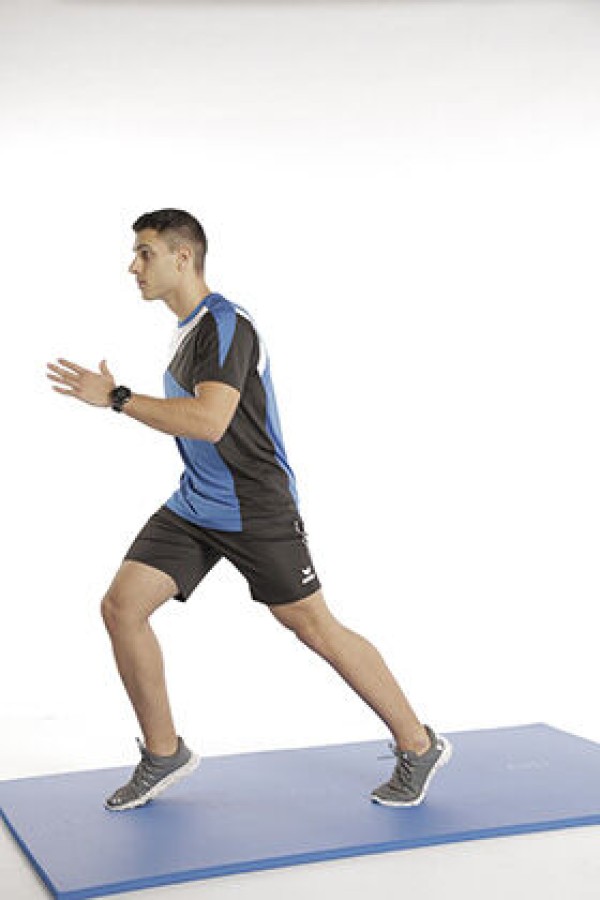
Cover a certain distance as quickly as possible/at a sprint.
No material required
Displacement exercise: jump forwards
Power
Individual work
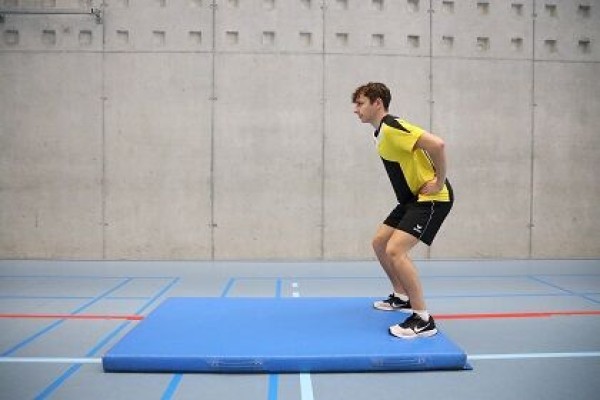
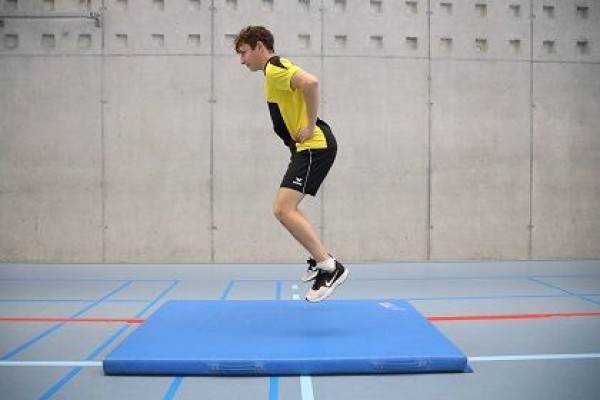

Stand with your hips wide apart, legs slightly bent and arms supported on your hips. Move forwards by jumping off with both legs (double jumps).
Attention:
Knees always remain behind the toes, maintain balance with bent knees after each landing.
Lighten:
Bend the knees less (greater angle); jump less forwards.
Harden
Bend your knees more (smaller angle); arms in front; additional weight (on the shoulders/legs).
Variant:
Arms not propped up or in front, but actively support the jump with your arms (with momentum).
2 weight cuffs/1 weight vest/sandbag ► Make the exercise more difficult (additional weight)
Shifting exercise: Jump forwards (frog hop)
Power
Individual work


Crouching position with your arms between your legs (touching the floor). Jump forwards with both legs and back to the starting position.
Attention:
Keep your back straight, cushion the landing.
Lighten:
Less long/high jumps.
Harden:
Additional weight (on the shoulders).
2 weight cuffs/1 weight vest/sandbag ► Make the exercise more difficult (additional weight)
Shifting exercise: Jump to the side forwards with one leg
Power
Individual work


Stand on one leg with the supporting leg slightly bent. Tilt your upper body forwards slightly and jump forwards to the side onto the other leg (alternating single-leg jumps). Keep your balance briefly before the next jump.
Attention:
Keep your knees stable and always behind the tips of your feet.
Lighten:
Bend your knees less (greater angle); jump less to the side/forward.
Harden:
Bend your knees more (smaller angle); hold additional weight (on your legs, on your shoulders, in front of your chest or in your hands); bend your knees more (smaller angle).
2-4 weight cuffs/2 weight balls/dumbbells/1 weight vest/weight disc/sandbag/fighting rucksack ► Make the exercise more difficult (additional weight)
Shifting exercise: Trotting
Power
Individual work


Cover a certain distance at a relaxed running pace/gait.
Variant:
Shake out your arms and legs at the same time.
No material required
Shifting exercise: Trotting with loosening exercises
Power
Individual work


Cover a certain distance at a relaxed running pace/gait, shaking out your arms and legs (loosening exercises).
No material required
Shifting exercise: forearm support
Power
Individual work
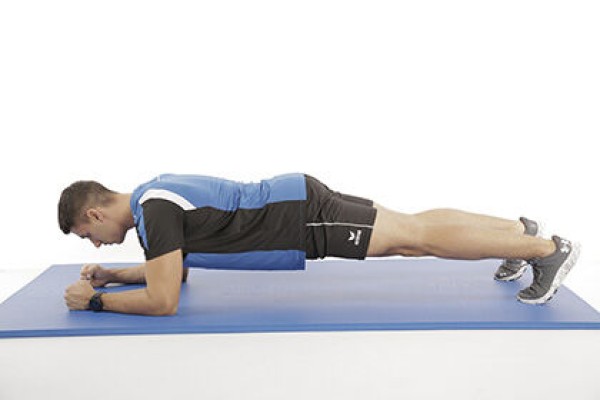

Shift forwards in forearm support by moving the forearms and legs.
Attention:
Do not arch your back, the upper body and legs should form as straight a line as possible.
Lighten:
Place your knees on the floor, stretch your buttocks slightly upwards.
Harden:
Additional weight (on your back).
Variation:
Shift sideways.
1 weight vest/weight disc/sandbag ► Make the exercise more difficult (additional weight)
Shifting exercise: four-foot stance (backwards)
Power
Individual work
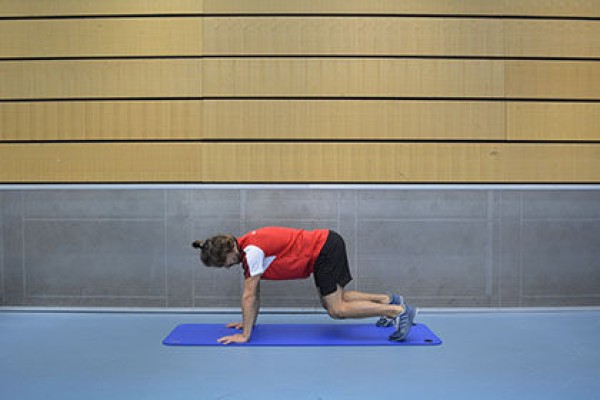



Shift on all fours. The arms are almost fully extended, the legs are bent and the chest is directed towards the floor. Movement is in the direction of the legs.
Attention:
Knees are not lowered.
Harden:
Additional weight (on the back).
Variation:
Forwards, backwards and sideways shifts are possible.
1 weight vest/weight disc/sandbag ► Make the exercise more difficult (additional weight)
Shifting exercise: four-foot stance (forwards)
Power
Individual work




Shift on all fours. The arms are almost fully extended, the legs are bent and the chest is directed towards the floor. Movement is in the direction of the arms.
Attention:
Knees are not lowered.
Harden:
Additional weight (on the back).
Variation:
Forwards, backwards and sideways shifts are possible.
1 weight vest/weight disc/sandbag ► Make the exercise more difficult (additional weight)
Shifting exercise: four-foot stance backwards (backwards)
Power
Individual work


Shift on all fours, arms almost fully extended, legs bent, chest facing upwards. The movement is in the direction of the arms.
Attention:
Do not lower the buttocks.
Lighten:
Buttocks closer to the floor (sagging).
Harden:
Additional weight (on the hips).
Variant:
Forwards, backwards and sideways shifts are possible.
1 weight vest/weight disc/sandbag to make the exercise more difficult (additional weight)
Shifting exercise: four-foot stance backwards (backwards)
Power
Individual work


Shift on all fours. The arms and legs are almost fully extended and the chest is pointing upwards. Movement is in the direction of the arms.
Attention:
The buttocks are not lowered.
Lighten:
The buttocks are closer to the floor (sagging).
Harden:
Additional weight (on the hips).
Variant:
Forwards, backwards and sideways shifts are possible.
1 weight vest/weight disc/sandbag ► Make the exercise more difficult (additional weight)
Shifting exercise: four-foot stance backwards (forwards)
Power
Individual work


Shift on all fours. The arms are almost fully extended, the legs are bent and the chest is facing upwards. Movement is in the direction of the legs.
Attention:
The buttocks are not lowered.
Lighten:
The buttocks are closer to the floor (sagging).
Harden:
Additional weight (on the hips).
Variant:
Forwards, backwards and sideways shifts are possible.
1 weight vest/weight disc/sandbag ► Make the exercise more difficult (additional weight)
Four-legged stance with arms raised
Power
Individual work




Progression I:
Adjust the sling trainer to mid-lower leg length (standing). Stand on four feet with your forearms in the slings, looking towards the floor (head in extension of the spine). Lift your knees (slightly) off the floor and hold the position.
Progression II:
Analogue progression I, but with support on your hands.
Progression III:
Analogue progression II, additionally bring your hands forwards.
Attention:
Keep your back straight, no hollow back.
Harden:
The more horizontal the body position and the further away the feet are from the attachment point, the more challenging the exercise becomes.
Variant:
For progression I+II, raise and lower the pelvis (do not put your knees down).
1 sling trainer
Four-legged stance with legs elevated
Power
Individual work





Progression I:
Adjust the sling trainer to the length of the centre of the lower leg (when standing). Stand with four feet on the forearms, feet vertically under the attachment point in the slings, looking towards the floor (head in line with the spine). Lift your knees off the floor and hold the position.
Progression II:
Analogue to progression I, but with the upper body supported on the hands.
Progression III:
Analogue to progression I, but with the upper body pushed back slightly with pressure from the shoulders and then returned.
Attention:
Keep your body tense, don't let your hips sag and keep your back straight (for all progressions).
Harden:
The further away your head is from the attachment point, the more challenging the exercise becomes.
Variant:
In progressions I+II, raise and lower your pelvis (don't put your knees down).
1 sling trainer
Dodgeball
Games / Tournament
Game idea:
Two equally sized pitches are divided by a centre line. The sky of both teams is located behind the baseline of the opposing team's pitch. One player is in the sky at the start of the game. During the game, each team tries to shoot the opposing players from their own pitch. Whoever is hit moves to the sky and can continue to try to hit opposing players with the ball from there. The player who is in the sky at the start of the game enters the playing field when a team-mate hits the ball for the first time. Anyone who catches a thrown ball keeps their life. The first team to run out of players loses the game.
Variations:
- A player who catches an opponent with the ball from the sky may return to the playing field.
- After a player lies down on his stomach in the sky, he may immediately attempt to run back into the playing field. If they are touched by an opponent while crossing the opponent's pitch, they must return to the sky.
- Two players can sneak out of the sky by piggybacking. If they are touched by an opponent while crossing the opponent's playing field, they must return to the sky.
- The last player in the playing field has several lives.
- There are 1-2 Swedish boxes in the playing field that can be used as cover.
- Each player (except those in the sky) places a cone in the playing field. If a cone is knocked over (by the ball or by touching it), the player who placed the cone goes to heaven.
- This variant begins in the same way as the basic form ends. One player is in the playing field, the rest start in the sky. The players in the sky try to hit the players in the field. If they succeed, they are allowed to enter the playing field, which continues to fill up. This makes it increasingly easier for the players in the sky to enter the playing field as the number of targets increases. Players hit in the playing field remain there. Which team is the first to run out of players in the sky?
- Each team secretly chooses a king and a jester. The sports director is informed of the choice. As soon as the king is chosen, the game is over. The jester cannot be hit and can therefore protect all players (including the king).
- Each team numbers its players in secret and gives the order to the sports director
volleyball
Games / Tournament
Game idea:
Two teams face each other on the volleyball court and play the ball over the net so that it falls to the ground in the opponent's court.
Score:
A point is scored if the ball lands in the opponent's court or the opposing team is unable to return the ball in accordance with the rules.
Court:
Volleyball court (9m x 18m) divided in the middle by a net. Net height 2.00m to 2.42m depending on the category.
Number of participants:
6 against 6
Rules of the game:
The serve is executed behind the baseline by the team that won the last point or has the right to serve and must be hit directly over the net to the other side. If the ball is in play, the team in possession of the ball has the right to hit the ball three times (plus block contact) to return the ball to the opponent's half of the court. The ball may not be caught or guided and may not be touched twice in succession by a single player. The ball may be played with any part of the body (exception: at the face-off). The net may not be touched by the players at the upper white band. The move lasts until the ball touches the ground, goes out of bounds or a team fails to return it properly.
If the right to play the ball is regained by scoring a point, the players change positions in a clockwise direction. A set goes to 25 points with a difference of at least 2 points, otherwise the game continues until a 2-point lead has been established. If a team can win 3 sets, the game is won.
Volleyball: Ball over the string
Forms of play / exercises
2 teams of 3-6 players
Game over the net with 2 teams of 3-6 players. The ball may be caught and is then thrown from the bottom to the top over the net into the opposing team's half of the pitch (no passing allowed within your own team). After each throw, the thrower runs around one of the cones, which are placed 1-2 metres outside the playing area. Each side has one cone next to the sideline and one behind the baseline. The opposing team catches the ball before it falls to the ground and then throws it back. Points for: Ball touches the ground, ball leaves the court, ball lands in the net.
Variant:
After a catch ball, 3 passes are allowed within the own team.
Pitch:
1 volleyball
1 volleyball net
6 cones
Volleyball: ball over the line combined with technique training
Forms of play / exercises
Group work
From the game of "ball over the string" to the game of "volleyball": The aim is to familiarise participants with the game of volleyball using simple game and exercise forms. The series of exercises is intended to help create more flow in the game of volleyball, which results in more fun than if the game consists almost exclusively of passing and errors.
1. Ball over the line:
Ball may be caught. Throw the ball over the net (only throws from bottom to top are allowed). After each throw, run around one of the cones, which are placed 1-2 metres outside the playing field. Each side has one cone next to the sideline and one behind the baseline. The opposing team catches the ball before it falls to the ground and then throws it back (no passes within the team). Points for: Ball touches the ground, ball leaves the court, ball lands in the net. Additional rule for better flow of play: the ball must be thrown into the back zone (over the 3 metre line).
2. Technique training: Manchette:
Demonstration by the sports leader (key points). Then practise in groups of 2 (at least 10 passes each)
3. Ball over the line combined with a cuff:
Same form of play as described above, but now the first touch of the ball after the opponent's throw over the net is with a cuff. After the cuff, the ball is caught by a team member and thrown to the opposite side. The run around the thrower's cones can still be maintained to create more free spaces (optionally, the passer must also perform the additional loop) or the rule can be omitted.
4. Technique training: 10-finger pass:
Demonstration by the sports leader (key points). Then practise in groups of 2 (at least 10 passes each)
5. Ball over the line combined with manchette and 10-finger pass:
Same game form as above. The first touch of the ball after the throw over the net is again with a cuff. The second touch of the ball must now be a 10-finger pass to a team-mate. Only then is the ball caught and thrown to the opposite side. The rule with the rounding of the cones can be retained (for throwers and passers) or cancelled.
6 cones
Per group:
1 volleyball